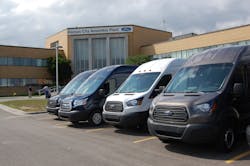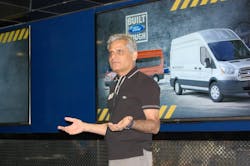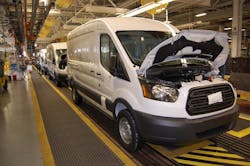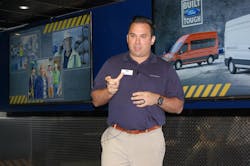Ford expects strong growth in global commercial-vehicle market
The global Class 1-7 commercial vehicle market is expected to grow by 13% between 2013 and 2017, according to Ford Motor Co. executives. That's because demand for more pickup, van, and medium-duty options will drive development of more “custom-capable” vehicle platforms.
“This is a very diverse vehicle segment,” explained Kumar Galhotra, VP-engineering for Ford during a ride-and-drive event held in Kansas City this week to show off the OEM’s new full-size Transit van, which went into full production back in April.
“The reason this segment is so diverse is because the customers themselves and their needs are so diverse – contractors, delivery firms, government agencies, and many others,” he said.Yet Ford’s approach to meet that need is to focus on building fewer and more globalized platforms upon which more customizable “top hat” body configurations can be placed, Galhotra (at right) noted – pointing to the new Transit as a prime example of this philosophy in action.
“We’ve taken the opportunity to combine the best traits of our previous E-Series vans in the U.S. [which the Transit replaces] and the Transit vans we built for the European market for the last 49 years into one platform,” he explained.
“Ten years ago, we sold several different platforms into different markets with different strategies – with the products sold in the U.S. very different from those sold in Europe,” Galhotra said. “Now we’re combining them [The E-Series and European Transit] into one platform with multiple configurations, yet one lowers the cost of ownership to the customer, improves on durability, while providing us with better scale.”Anthony Piazza, Ford’s assistant marketing manager for Transit, Transit Connect, and E-Series, told Fleet Owner that being able to offer more options with one platform helps the OEM better serve the customer while reducing vehicle production costs.
“This segment [commercial vans] is evolving, but the most important thing about it is giving the customer what I call the ‘power of choice,’” he said. “With the new Transit, you get three roof heights, two wheelbase choices, and three engine options [two gasoline and one diesel] along with optional factory-installed prep packages for alternative fuels. That allows us to accommodate almost any type of business with this one product.”
The upside for Ford, of course, is the potential size of the van market the new Transit can serve. Golhorta noted that Ford has sold 8 million E-Series units since that model line’s introduction in 1961, while selling 7 million units of the Transit’s European predecessor since 1963.Piazza (at right) added that in 2013 alone, Ford sold 125,356 E-Series units, and hopes to build on those numbers as the new Transit filters out into the market this year.
“We’re hoping to change the mentality of a lot of customers and potential customers when it comes to the capability of commercial vans,” he stressed. “We’re talking about vehicles that offer double-digit fuel mileage while providing more cargo payload, more towing capability, and higher roof options.”
For example, Piazza said the “step-up” from the Transit’s 83.6-in. “low roof” configuration to its 100.8-in. medium-roof option only moves the van’s base price upwards by about $1,000 – all while providing more cargo volume capacity.
“And when customers start penciling that in with the fuel economy savings, that’s when they are really going to see the value in the new Transit,” he emphasized. “That’s why the new Transit is a ‘win-win’ for everyone – for us, for our suppliers, and especially our customers.”
About the Author
Sean Kilcarr
Editor in Chief
Sean Kilcarr is a former longtime FleetOwner senior editor who wrote for the publication from 2000 to 2018. He served as editor-in-chief from 2017 to 2018.



